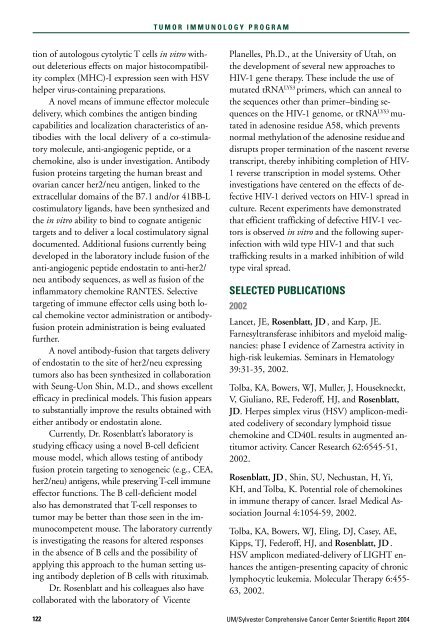SCIENTIFIC REPORT 2004 - Sylvester Comprehensive Cancer Center
SCIENTIFIC REPORT 2004 - Sylvester Comprehensive Cancer Center
SCIENTIFIC REPORT 2004 - Sylvester Comprehensive Cancer Center
Create successful ePaper yourself
Turn your PDF publications into a flip-book with our unique Google optimized e-Paper software.
T U M O R I M M U N O L O G Y P R O G R A M<br />
tion of autologous cytolytic T cells in vitro without<br />
deleterious effects on major histocompatibility<br />
complex (MHC)-I expression seen with HSV<br />
helper virus-containing preparations.<br />
A novel means of immune effector molecule<br />
delivery, which combines the antigen binding<br />
capabilities and localization characteristics of antibodies<br />
with the local delivery of a co-stimulatory<br />
molecule, anti-angiogenic peptide, or a<br />
chemokine, also is under investigation. Antibody<br />
fusion proteins targeting the human breast and<br />
ovarian cancer her2/neu antigen, linked to the<br />
extracellular domains of the B7.1 and/or 41BB-L<br />
costimulatory ligands, have been synthesized and<br />
the in vitro ability to bind to cognate antigenic<br />
targets and to deliver a local costimulatory signal<br />
documented. Additional fusions currently being<br />
developed in the laboratory include fusion of the<br />
anti-angiogenic peptide endostatin to anti-her2/<br />
neu antibody sequences, as well as fusion of the<br />
inflammatory chemokine RANTES. Selective<br />
targeting of immune effector cells using both local<br />
chemokine vector administration or antibodyfusion<br />
protein administration is being evaluated<br />
further.<br />
A novel antibody-fusion that targets delivery<br />
of endostatin to the site of her2/neu expressing<br />
tumors also has been synthesized in collaboration<br />
with Seung-Uon Shin, M.D., and shows excellent<br />
efficacy in preclinical models. This fusion appears<br />
to substantially improve the results obtained with<br />
either antibody or endostatin alone.<br />
Currently, Dr. Rosenblatt’s laboratory is<br />
studying efficacy using a novel B-cell deficient<br />
mouse model, which allows testing of antibody<br />
fusion protein targeting to xenogeneic (e.g., CEA,<br />
her2/neu) antigens, while preserving T-cell immune<br />
effector functions. The B cell-deficient model<br />
also has demonstrated that T-cell responses to<br />
tumor may be better than those seen in the immunocompetent<br />
mouse. The laboratory currently<br />
is investigating the reasons for altered responses<br />
in the absence of B cells and the possibility of<br />
applying this approach to the human setting using<br />
antibody depletion of B cells with rituximab.<br />
Dr. Rosenblatt and his colleagues also have<br />
collaborated with the laboratory of Vicente<br />
122<br />
Planelles, Ph.D., at the University of Utah, on<br />
the development of several new approaches to<br />
HIV-1 gene therapy. These include the use of<br />
mutated tRNA LYS3 primers, which can anneal to<br />
the sequences other than primer–binding sequences<br />
on the HIV-1 genome, or tRNA LYS3 mutated<br />
in adenosine residue A58, which prevents<br />
normal methylation of the adenosine residue and<br />
disrupts proper termination of the nascent reverse<br />
transcript, thereby inhibiting completion of HIV-<br />
1 reverse transcription in model systems. Other<br />
investigations have centered on the effects of defective<br />
HIV-1 derived vectors on HIV-1 spread in<br />
culture. Recent experiments have demonstrated<br />
that efficient trafficking of defective HIV-1 vectors<br />
is observed in vitro and the following superinfection<br />
with wild type HIV-1 and that such<br />
trafficking results in a marked inhibition of wild<br />
type viral spread.<br />
SELECTED PUBLICATIONS<br />
2002<br />
Lancet, JE, Rosenblatt, JD , and Karp, JE.<br />
Farnesyltransferase inhibitors and myeloid malignancies:<br />
phase I evidence of Zarnestra activity in<br />
high-risk leukemias. Seminars in Hematology<br />
39:31-35, 2002.<br />
Tolba, KA, Bowers, WJ, Muller, J, Housekneckt,<br />
V, Giuliano, RE, Federoff, HJ, and Rosenblatt,<br />
JD. Herpes simplex virus (HSV) amplicon-mediated<br />
codelivery of secondary lymphoid tissue<br />
chemokine and CD40L results in augmented antitumor<br />
activity. <strong>Cancer</strong> Research 62:6545-51,<br />
2002.<br />
Rosenblatt, JD , Shin, SU, Nechustan, H, Yi,<br />
KH, and Tolba, K. Potential role of chemokines<br />
in immune therapy of cancer. Israel Medical Association<br />
Journal 4:1054-59, 2002.<br />
Tolba, KA, Bowers, WJ, Eling, DJ, Casey, AE,<br />
Kipps, TJ, Federoff, HJ, and Rosenblatt, JD .<br />
HSV amplicon mediated-delivery of LIGHT enhances<br />
the antigen-presenting capacity of chronic<br />
lymphocytic leukemia. Molecular Therapy 6:455-<br />
63, 2002.<br />
UM/<strong>Sylvester</strong> <strong>Comprehensive</strong> <strong>Cancer</strong> <strong>Center</strong> Scientific Report <strong>2004</strong>
















